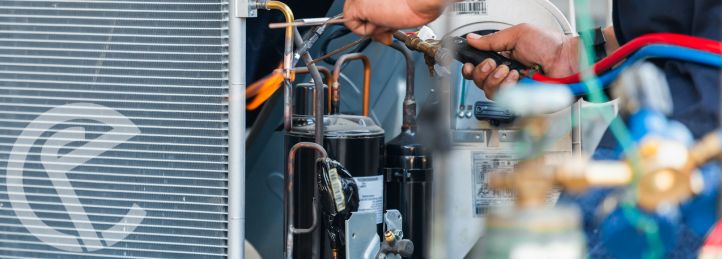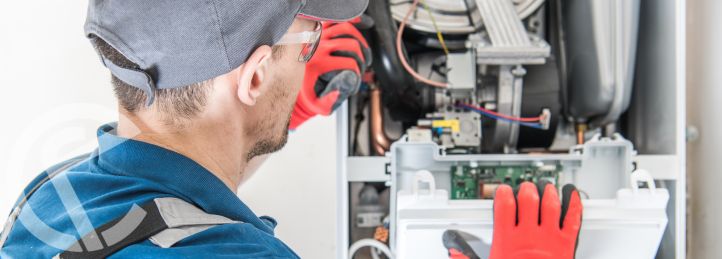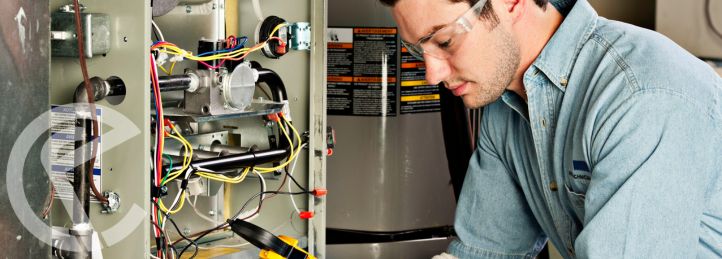Heating Services in San Antonio, TX

While Texas winters may be mild compared to other regions, reliable home heating is still essential during the chilly months. At Evenflow Home & Commercial Services, we deliver expert heating services to keep your home comfortable, safe, and energy efficient throughout the season. Our locally owned, faith-based team brings integrity, skill, and service to every heating project.
- We Are Locally Owned and Operated: With deep ties to the San Antonio community, we understand the unique climate and heating needs of our neighbors.
- 100% Satisfaction Guarantee: Your comfort is our mission. If you’re not completely satisfied, we’ll make it right.
- Focused on Superior Customer Support: From start to finish, we provide friendly, professional service you can trust.
Whether you need a tune-up, emergency repair, or a full heating system replacement, Evenflow Home & Commercial Services is here to help.
Where your service flows smoothly from start to finish: we guarantee it. Schedule service with Evenflow Home & Commercial Services today.

Why Choose Evenflow Home & Commercial Services for Heating Service in San Antonio?
Homeowners throughout San Antonio choose us because we offer more than just technical know-how; we offer compassionate service and honest recommendations. Our team is trained to handle all types of heating systems and provides customized solutions based on your home and family’s needs.
We’re proud to be a highly rated and award-winning service provider recognized for transparency, reliability, and community values.
A Trusted Name in Local Heating Solutions
We’ve earned our reputation one home at a time with exceptional workmanship and a dedication to doing what’s right.
- Voted Top Service Company on Home Advisor: Our customers continue to rank us as one of the best in the area.
- Rated "A" by the Better Business Bureau: A proven track record of dependable, ethical service.
- Flexible Scheduling and On-Time Arrival: We work around your availability and arrive prepared to solve your heating issues promptly.
Comprehensive Heating Services for Every System
Our team is equipped to service all major heating system types, including gas furnaces, heat pumps, and electric units.
- Heating Repairs: We diagnose and repair all brands and models. Whether your system isn’t starting or you’re experiencing uneven heat, we’ll fix it fast.
- System Installations: We design and install energy-efficient heating systems tailored to your home’s layout and budget.
- Preventive Maintenance: Regular checkups ensure your heater is ready before the cold hits and help avoid emergency repairs.
- Smart Thermostat Setup: Get full control over your home’s comfort and reduce heating costs with modern controls.
- Air Quality Enhancements: We can add humidifiers or air purifiers to your heating system to improve indoor comfort during dry winter months.
Straightforward Pricing and Quality Work
We believe in honesty at every step. You’ll never face hidden fees or pressure tactics.
- Clear Estimates Before We Start: You approve every job before we begin.
- Affordable Options and Financing: We offer a variety of systems and payment plans to suit your budget.
- Guaranteed Workmanship: We do the job right the first time, with warranties on parts and labor.
Looking for a heating company that values faith, fairness, and your family’s comfort? Call Evenflow Home & Commercial Services today.
Get Reliable Heating Help When You Need It
Don’t get caught in the cold. Whether it’s a sudden breakdown or an overdue upgrade, Evenflow Home & Commercial Services is ready to help.
Request your free heating estimate or schedule a service visit with San Antonio’s trusted team.
Common Heating Problems in San Antonio Homes
While winters in San Antonio may not be severe, a failing heating system can still cause major discomfort and leave your family vulnerable to cold snaps. At Evenflow Home & Commercial Services, we help local homeowners spot the warning signs of heating trouble and take fast action to restore warmth and reliability.
Typical Heating System Issues:
- Uneven Heat Distribution: If some rooms feel warm while others stay cold, your system may have airflow issues, duct imbalances, or an aging blower motor.
- Cold Air Blowing From Vents: This is often a sign of a faulty ignitor, gas valve problem, or malfunctioning heat exchanger, especially in gas furnaces.
- Frequent Cycling On and Off: Short cycling wastes energy and puts extra strain on your system. It’s usually caused by thermostat misreads, dirty filters, or an improperly sized unit.
- Strange Noises: Banging, grinding, or squealing sounds may point to worn belts, loose parts, or failing motor bearings.
- Unresponsive Thermostat: If your system doesn’t respond to your temperature settings, it could be due to faulty wiring, sensor issues, or an outdated thermostat.
- Sudden Increase in Energy Bills: A drop in system efficiency or hidden malfunctions often show up first on your utility bill.
- Gas Odors or Carbon Monoxide Alerts: These are urgent red flags. Evacuate your home and call for immediate professional assistance if you suspect a gas leak or CO issue.
Fast action not only keeps your home comfortable but can also prevent expensive repairs or safety risks down the road.
Noticing a heating issue? Call Evenflow Home & Commercial Services right away for prompt, accurate repairs that protect your comfort and safety.
Key Components of a Residential Heating System
Your home’s heating system relies on several interdependent parts to function smoothly. Understanding them helps you recognize when something may be going wrong.
- Furnace or Heat Pump: The main unit that heats air (furnace) or transfers heat (heat pump). Failure in these components often results in no or weak heating.
- Heat Exchanger (Gas Furnaces): Transfers heat from combustion gases to the air. A crack can lead to dangerous carbon monoxide exposure.
- Blower Motor and Fan: Circulates warm air throughout your home. Problems here reduce airflow and increase energy consumption.
- Burners and Ignition System: Responsible for starting the heating process. Dirty burners or a faulty ignitor prevent your system from firing up.
- Thermostat: Controls the operation of your heating system. Inaccurate readings or faulty wiring can cause inconsistent performance.
- Air Filters: Trap dust and debris before they reach internal components. A clogged filter restricts airflow and puts stress on your system.
- Ductwork and Vents: Deliver heated air to each room. Leaky or poorly insulated ducts cause heat loss and uneven temperatures.
- Flue and Venting System: Directs combustion gases safely out of the home. A blockage or leak here poses serious safety concerns.
Our team at Evenflow Home & Commercial Services checks each of these components during diagnostics or maintenance to ensure your system is safe, efficient, and ready for the season.
Don’t wait for a breakdown. Book a seasonal tune-up or repair visit now and enjoy worry-free warmth.

Full-Service Heating Options for San Antonio Homes
At Evenflow Home & Commercial Services, we know your family relies on dependable heat during cooler Texas months. Our comprehensive heating services cover everything from new system installations to urgent repairs and routine maintenance. No matter your need, our locally owned team delivers comfort with care and integrity.
Heating Installation and Replacement
When to Consider
It might be time for a replacement if your heating system is more than 12-15 years old, has frequent repair issues, or no longer provides consistent warmth. High utility bills or an outdated thermostat are also signs it’s time to upgrade.
Why It’s Important
Installing a new heating system improves energy efficiency, enhances indoor comfort, and ensures safety. A correctly sized and professionally installed system offers even heat and better humidity control.
What’s Included
- Home assessment and sizing analysis: We evaluate your home’s square footage, insulation levels, window exposure, and usage habits to recommend the perfect system size and type.
- Energy-efficient system selection: You’ll have access to trusted brands with advanced features like variable-speed blowers, gas furnaces with high AFUE ratings, and quiet performance.
- Safe removal of old equipment: Our team disconnects and removes your old furnace or heat pump safely, adhering to local disposal and recycling standards.
- Flawless installation and calibration: We connect gas or electric lines, adjust ductwork as needed, and calibrate settings to match manufacturer specs for optimal performance.
- Smart thermostat setup: Choose a programmable or Wi-Fi thermostat for convenience and control, and we’ll handle the configuration and integration.
- Post-install walkthrough: Once installed, we’ll guide you through how to use your system, explain filter changes, and answer all your comfort-related questions.
Book Your Heating Installation Today
Ready for reliable warmth? Trust Evenflow Home & Commercial Services for a seamless installation experience.
Heating Repair
When to Consider
Call for repair if your system is blowing cold air, cycling too often, making unusual sounds, or producing strange smells. Don’t ignore high energy bills or frequent on-off cycling either; they often signal deeper problems.
Why It’s Important
Fast, effective repairs restore comfort, prevent further damage, and protect your home’s safety. Addressing issues early saves time and money down the road.
What’s Included
- Comprehensive diagnostics: We perform electrical testing, inspect internal components, and use thermal imaging when needed to pinpoint the issue.
- Transparent repair options: Before any work begins, you’ll get a detailed explanation of the issue along with clear, budget-friendly solutions.
- High-quality replacement parts: We use durable OEM or equivalent components that meet or exceed factory standards.
- Certified service on all brands: Our technicians are trained to repair systems from major manufacturers like Lennox, Goodman, Trane, Rheem, and more.
- System testing and safety checks: After repairs, we verify ignition cycles, temperature differentials, airflow, and safety controls for peace of mind.
Stay comfortable with quick, courteous service from the pros at Evenflow Home & Commercial Services.
Heating Maintenance
When to Consider
Annual maintenance is best scheduled in early fall. Older systems, homes with pets, or those with indoor air concerns may benefit from biannual tune-ups.
Why It’s Important
Preventative service reduces breakdown risks, improves efficiency, and ensures your home stays warm when it matters most. It also helps validate your manufacturer’s warranty.
What’s Included
- 20+ point inspection and tune-up: We inspect burners, heat exchangers, ignition systems, motors, wiring, and all safety controls.
- Thermostat calibration and airflow testing: We confirm your thermostat settings align with actual system performance and adjust airflow for balanced heating.
- Gas and electrical component checks: From checking gas pressure to inspecting capacitors and connections, we ensure every part is safe and operational.
- Duct and vent review: We check visible ductwork for leaks, loose joints, insulation gaps, and signs of blockages or mold.
- Service report and maintenance log: You’ll receive a written summary of work completed, system condition, and any recommended future repairs or upgrades.
Avoid winter breakdowns and high bills, schedule your maintenance with Evenflow Home & Commercial Services today.
From first-time installations to fast repairs and proactive maintenance, Evenflow Home & Commercial Services is your local partner for warm, safe, and stress-free heating.
Contact us now to book your heating service or get a no-obligation estimate.
